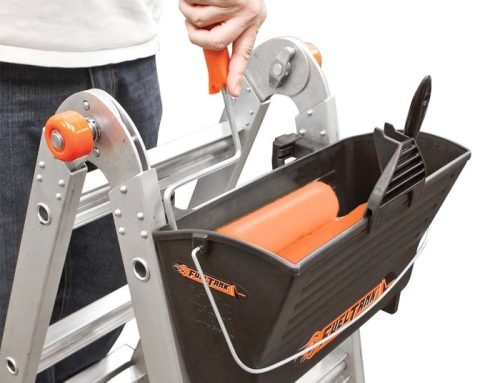Using step ladders should always, as with any type of ladder, be done safely. Anyone climbing a ladder should have the correct footwear, hard-hat (when appropriate) and any other protective equipment needed for the job. Even with the correct kit, accidents can still occur if the ladder itself is not up to scratch. Always check step ladders for signs of damage, especially to the rungs and the joints and between the rungs and stiles. Damage can include rust, cracks, erosion, woodworm and excessive wear and tear. The stiles and rungs of a step-ladder should always be checked for grease or oil that could cause poor grip and any safety features of the step ladder, such as locking points, should be inspected and tested before the step-ladder is used. If the step ladder has a platform, check this for cracks carefully if you intend to rest any weight on it.
The Importance of Checking Your Stepladder
This is especially important for older stepladders that are wooden. Recently a grandmother suffered severe injuries after using an old timber step ladder. 82-year-old Ruth Robinson was using her step-ladder to hang curtains in her home in Somerset when the platform of the step ladder she was standing on collapsed and she fell through. She received lacerations on her legs and stomach as well as a stab wound to the stomach, caused by a piece of the broken step ladder. She was also left wedged and dangling in the frame. Mrs Robinson’s husband fetched a neighbour, while she called an ambulance. Their neighbour, who happened to be the Yeovil town crier, Bruce Trigger, held Mrs Robinson up to stop the step ladder digging into her and causing more damage, for ten minutes until the ambulance arrived. When firefighters arrived they sawed her free within three minutes and she was rushed to hospital. She is recovering from her injuries and wants to make sure others are aware of the dangers of faulty or damaged step-ladders. The Robinson’s daughter said she would have taken the stepladder out of the house had she known it was there, as it was unsafe for her mother to be using it, especially with it being that old. The step ladder in question has since been destroyed (the Robinsons burnt it)
Uses for Old Ladders
Step ladders that have passed their “use-by date” can always be used ornamentally in the home and garden: as plant pot stands, towel rails, bedside tables, trestles for a coffee table, a shoe rack, clothes storage, hat rack, pot stand in the kitchen, the list goes on. So, even when your older models are no longer in fit shape for a working step ladder, they can be very useful and attractive. Check your step ladder before you use it next and if you have any doubts about using it, replace it. In the case of buying a stepladder for Mrs Robinson, the Little Giant Safety Steps would be an excellent choice. Available in models of two to four treads, these rugged, yet lightweight step ladders feature the patented ‘Tip ‘n Glide’ wheels making the unit easy to wheel around the home, so no need to pick it up (unless moving between floors). The extra wide treads are more like staircase steps and the safety rail at the top provides a large hand-hold. Little Giant claim this step-ladder can be opened and closed with one hand, which is certainly a plus point for people with arthritis or stiff joints. The tallest model has a top tread height of 91 centimetres, which is enough height to change lightbulbs and reach high shelves or cupboards. Or, indeed, to hang curtains.






Leave A Comment
You must be logged in to post a comment.